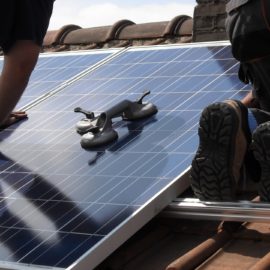
We want it. Industry wants it. Is there enough clean energy for all?
Back in March, Entergy Louisiana filed an immense request with the state Public Service Commission. The state’s largest electricity provider, Entergy asked for the PSC’s blessing to expand its solar power capacity by 3 gigawatts, quite a leap from the utility’s 10-gigawatt portfolio. Though exact figures are hard to calculate, such a total could power 519,000 homes, based on estimates from the Solar Energy Industries Association. The unusual part of the ask is that Entergy Louisiana is still trying to identify where that power will come from. But company officials said the unconventional approach was needed to speed up a yearslong regulatory process so it can meet its customers’ renewable power demand. However, company officials noted that, while the solar power would be available for the entire grid, the demand is coming primarily from its industrial customers, and not necessarily its residential users. “This is being driven by their customers asking for cleaner projects, and we’re here to help them accommodate their goals,” Entergy Louisiana President and CEO Phillip May said in March.
nola.com
Despite the love of oil the industrial energy sector is moving to renewables.
The admission isn’t surprising, given that Louisiana’s industrial sector is shuffling toward a cleaner carbon footprint. It’s also emblematic of the conundrum facing Louisiana’s power grid — industrial customers need renewable power to fuel a wave of clean energy projects, but residents can’t be left in the dark. As Louisiana’s renewable power sector grows, consumer advocates worry the state’s industrial corridor will absorb all of the available clean energy, leaving residents stuck with fossil fuel power that is subject to global natural gas price volatility. However, Entergy officials and industry advocates say the ongoing expansion of renewable energy should generate enough power for all customers to benefit from greater bill stability. “Any new reasons to invest in clean energy resources is good news,” said Logan Atkinson Burke, executive director of the Alliance for Affordable Energy, a New Orleans-based consumer watchdog group. “The greatest concern that I have is if these renewables are sort of financed in such a way that means that residents don’t see those benefits. There’s a world in which an industrial customer is basically competing with other customers for access to that cheaper power. That’s not good news.”
We have under 300 megawatts of solar energy, 38th in the nation.
Louisiana has about 276 megawatts of solar power, a figure that ranks 38th nationwide, according to the Solar Energy Industries Association. The state also has “little wind energy resource potential and no utility-scale wind power generating facilities,” according to the U.S. Energy Information Administration. Meanwhile, nearly two-thirds of the state’s electricity is generated using natural gas, according to the EIA. About 4% comes from renewable power. Amid global volatility in natural gas prices, utility costs in Louisiana soared last year, hurting the state’s low-income residents, Burke said. She said her group routinely received phone calls from residents complaining about $600 electricity bills for several months in a row. “Those who are exposed to that volatility really feel it,” Burke said. That’s why expansions like Entergy’s are so notable.
Entergy now has 2 gigawatts of power and this will bring them up to 27, a 12% increase.
To put the 3-gigawatt expansion into perspective, Entergy Corp. has 24 gigawatts across all of its markets. An additional 3 gigawatts would represent a 12.5% growth for the entire company. After announcing the expansion, May said solar power should help make electricity bills more stable for all of its customers. “Over the last couple of years, solar has become highly competitive, particularly with what we’ve seen with volatility in gas prices,” May said. “Solar is an economic resource. It also is a resource that will help with volatility in gas prices, so customers will see more stable bills instead of bills that could hike when prices spike.” Burke said industrial companies have recognized the economics of renewable energy. However, that means industrial customers could wind up competing with residents for a slice of Louisiana’s small renewable pie. At least half of the state’s electricity is used by industry, Burke said. Louisiana’s looming industrial buildout — economists estimate tens of billions of dollars’ worth of projects are on the horizon — will only add to that figure. “That percentage is likely to be way over 60% or 70% if all of that buildout actually happens,” she said.
Entergy says the solar will be for all customers.
Entergy Louisiana officials affirmed that the 3-gigawatt solar expansion would be available for all of the utility’s customers. It will also be part of the company’s Geaux Green program, which allows customers to receive a bill credit in exchange for paying a fee for solar power. “The power produced through future renewable sources like solar would be placed on the power grid, which will benefit all customers (including residential) rather than going only to a specific set of customers,” Entergy spokesman David Freese said in a statement. May noted in March that industrial clients will help cover the costs of Entergy’s solar expansion, which would ease the burden on the utility and its customers. Lacy McManus, executive director of future energy for GNO Inc., raised a similar point. McManus — whose organization is pushing for expanded wind power amid a statewide “green” hydrogen push — questioned whether Louisiana’s residents can pay for renewable energy construction, especially after natural gas price spikes and hurricane recovery costs. She said it makes sense for industry to step in as the renewable power market’s first players. “If you step back and then say, ‘Who can shoulder those costs if renewable energy is coming online?’ — the industrial sector to me makes likely more sense than the residential sector,” McManus said.
The state needs to take renewable seriously and recognize they are n ot only here but will cut back on oil.
To ensure equity for all, Burke said Louisiana should continue exploring a renewable portfolio standard, or a requirement that a certain percentage of electricity comes from renewable sources. “A part of a renewable portfolio standard policy can be expressly about ensuring that residents are benefiting from that transition,” she added. When asked about a renewable portfolio standard, McManus pointed to the state’s climate action plan as a blueprint for Louisiana’s pursuit of renewable energy. Both McManus and Burke noted that the Midcontinent Independent System Operator, the electricity grid operator better known as MISO, will have to better plan for wind energy transmission in the near future. McManus said GNO Inc. has already had conversations with Entergy and the Alliance for Affordable Energy about MISO’s role in distributing offshore wind power from the Gulf of Mexico. “We know that the long-term transition planning is certainly going to be a linchpin in getting all of this going and making sure that the end users, be they industrial or be they residential, are able to have access to renewable energy,” she said.
Now we just need to find the soar farms.



